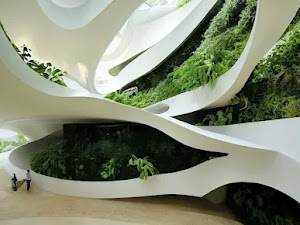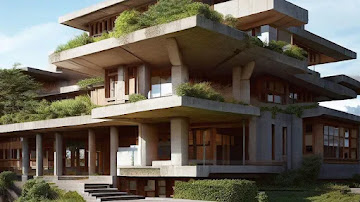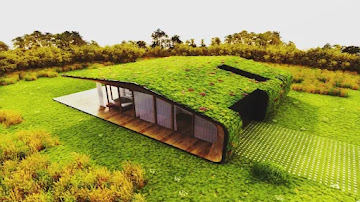How to Understand Architecture and What is Its Definition?
What do you imagine when you think of architecture and
urbanism? Surely drawings, shapes, and colors, names of the best-known
architects and their trajectories, or a video of Abraham's high walls in
advanced architecture. In short, it happens that the connotation of this
discipline harbors an endless number of almost poetic meanings.
We will unravel as far as possible what we know today as an
architecture platform. Historically speaking, first of all, let's answer the
enigmatic question you've been asking yourself for centuries, or maybe not,
but, in any case, here are some possible definitions you can identify with.
Definition of Architecture
Let's start with the easy way, in a few words and according
to the definition provided by Oxford languages, architecture is: "The art
and technique of designing, projecting and constructing buildings and public
spaces". How assertive don't you think, but surely you want to know what
architecture is, in all its splendor.
Sounds good, doesn't it? Now, this short definition of
architecture will not be enough for us to understand the origin of architecture
as one of the fine arts since it can be more than that, or so we think. For
now, don't worry about: How many points can I study for a degree in
architecture?
The meaning of architecture, form, space, and order seems to
be a rather trite worldview of the word and that in different historical
periods has been attributed a myriad of meanings, according to human perception
and the various prodigies and non-prodigies who addressed this path.
As a consequence, and unlike other art forms, it resulted in
extreme historical and cultural diversity. As expressive and free as it may
seem, it is quite conditioned by the egocentric desires of society.
Being an extensive field in theory and practice, it has
become one of the famed fine arts, which, over time has been described by
theorists, teachers, and critics as the combination of geometry and visual
composition.
Thus creating an empirical and phenomenological vision, as
opposed to formalism, which challenges the way of understanding and teaching
the four most popular branches of architecture. From this, architectural
appreciation and understanding differ, since it is displaced in 2 professional
followers that are formalism and functionalism.
On the other hand, in terms of "evolution", it no
longer has a limited expression and can now be widely explored using
architectural cad programs or computer-aided design software. In any case, it
is normal that architecture in motion has so many meanings, concepts, and
styles, its development is unquestionable as everything flows and changes over
time.
History of Architecture and Its Evolution
Don't go to sleep yet! It is important to doubt and try to
understand the origin of any timeline event. History explores the development
of architecture in the country, including its principles, concepts, and
achievements. We will have to turn to the past so that we can now understand
what modern architecture and construction are all about.
Like any other type of historical event, this field is
subject to the limitations and strengths of history as a science: there are
several versions of its study, most of which are of Western origin.
Architectural periods are covered historically in most cases
and do not always coincide with those of the history of ancient art and
architecture. Aesthetic ideals also occasionally overlap or blend. These
developments are not fully documented. In the following paragraphs, the
evolution and origin of architecture as one of the fine arts will be explained
as a timeline.
Architecture in Prehistoric Times
Due to the nomadic way of life in the prehistoric era, the
first shelters implemented and used by humans were ephemeral and mobile like a
tiny house. Usually, the camps were made of light and easily transportable
materials, such as bones, skins, and wood. This resulted in this introduction
to architecture through pre-Hispanic origin, posthumous to the current
civilization.
When they left the caves, they began to create small villages
or more elaborate communities, which forced these complex settlements to use
durable materials such as skins, stone, and wood.
500,000-year-old pillar pits have been discovered in a layer
of volcanic ash near Chitibu, Japan. Stone lines discovered in France form the
basis of 400,000-year-old pole constructions. Impressive, but there's more.
As the primary structure of prehistoric societies, the
shelter would be the focal point of their spatial organization. Several
architectural theorists throughout history have used the myth of the primordial
hut, including Vitruvius in antiquity, Leon Battista Alberti in the
Renaissance, and, more recently, Joseph Rickworth. And well, so as not to bore
you and without so much ado, this is how it all began. This architectural
information will someday cease to be valuable, don't forget to share.
Its Development in Antiquity
At this stage, two main trends are known, Mesopotamian
architecture and that of ancient Egypt. These cultures contributed important knowledge
that served as a guide for the builders of subsequent generations. Ancient
Egypt originated approximately 3150 B.C. But Egypt and Mesopotamia did not
become what we know today until 2649 B.C.
Classical Antiquity
Surely in this block more or less you will already have an
idea of the architectural orders that took place during this era. From the
Greeks and Romans emerged great philosophers and thinkers such as Socrates and
Aristotle, however, the architectural vision that emanated from these cities changed
the course of Mexican architecture of our days.
Middle Ages
This block houses the development of Romanesque, Islamic,
Paleochristian, Byzantine, and Gothic architectural styles. There are quite a
few of them, since in this period more construction techniques were already
known and there was greater knowledge in the use of materials.
Modern Age
How is history going? Don't answer, because we know that
this topic is getting a little tiring. The doubts in the air are still present
so, let's continue. The modern age gave us as gift the Renaissance, baroque,
and rococo. Le Corbusier's architecture is an example. With its beautiful and
exuberant finishes, it illuminated the world. Let's see what this is all about.
Contemporary Period
After the French Revolution, there is a boom in this
architecture report and it is certainly possible that even minimalism enters
this ranking. Nevertheless, we present you the following.
Types and Styles of Architecture
Have you ever looked at a building and wondered if it is Bauhaus
or Modernist? Often, types of architecture and their styles build on each
other, and in each past period, the foundations for the advancement of the next
culture are built. Just think of the lasting influence of the pyramids of Giza
or classical Greek temples. This discipline includes a wide range of
applications, styles, and aesthetics. This requires a variety of
classifications, the most important of which the following two distinct forms
are known:
- Historical or stylistic architecture: this category includes
Baroque cathedrals, Roman monuments, and other architectural structures whose
fundamental feature is their concordance with their period and culture of
origin.
- Traditional or popular architecture: Those structures
designed by amateur architects who give greater priority to functionality than
to aesthetics.
To distinguish types of architecture in other areas,
different criteria can be used such as:
- Function: Works are divided into religious, military, and
civilian categories based on their use.
- Period: This classification considers the works as
historical documents, identifying the period in which they were erected
according to their style, ornamentation, and materials: Baroque, Roman,
Neoclassical, Gothic, etc.
One of the best definitions of architecture examples that we
know of the idea of existing classes and styles comes from a literary text by
Victor Hugo in his novel Notre Dame de Paris.
Great buildings, like great mountains, are the work of
centuries. Often art is transformed when it is not yet finished: the work
continues peacefully according to the transformed art.
The new art brings the monument to where it is. It is done
following a natural and silent law. This is what happened in Europe during the
Christian era. Whatever the development of the sculptor and the embroidery of a
cathedral underneath, it is always the Roman basilica that develops eternally
on the ground according to the same law.
But what does architecture study? Some critics of
introspective architecture to resolve this conflict between the type and its
temporality tend to circumscribe the notion of type in the narrow margins of a
dichotomy according to which the type is a mere byproduct of the historical
process, a result that would lead mechanically the material development and
repetition of identical needs, or it would be a historical and superhuman
category, pre-existing to its particular manifestations.
The styles created by us derive from our effort to make the
deep structure of the material world recognizable and intelligible. The type is
the product of a human work capable of understanding reality and endowing it
with an order through architectural news.
When we speak of the various architectural types, therefore,
refer to historical categories because, escaping strictly evolutionary
explanations and chronological reductions, they germinate and are necessarily
and fatally transformed in the field of historical experience.
For this reason, we have selected different types of
architecture with styles and characteristics to help narrow the field of
architectural visualization when a building is appreciated from the outside.
What is the Concept of Architecture?
It is a very complex and multifaceted concept. First of all,
it is a material reality in the form of various types of buildings, structures,
and their complexes designed to satisfy man's material needs.
But it is also a special art that can express great ideas
and bring aesthetic pleasure. In this sense, architecture is understood as the
presence of certain artistic and compositional features, depending on the
purpose and role of a building or structure in urban planning.
Main Elements and Characteristics of Architecture
Architectural correlates have unique characteristics that
are fascinating to know. Their characteristics can be detected according to
style. However, some of these characteristics are shared by all styles.
Professionals often have several design distinctions when developing a project.
The characteristics in architecture that make up an
architectural project vary in appearance, construction, materials, and
historical time, which apply to all architectural styles including today's
architecture.
What is architecture and what is its purpose in society?
We can understand that architecture is the set of ideals and
norms of life of each community that employs structures in its daily life. It
represents the tangible manifestation of these principles, expressing the growth
and evolution of the world and society.
Its usefulness consists in giving a tangible response to the
phenomenology of living, more correctly as those that meet utilitarian
requirements and at the same time possess the qualities of beauty.
Because the architecture and design of houses reflect the
needs, values, and interests of many human civilizations throughout history, it
is an important cultural expression that helps us to better understand how
people have interacted with their environment over time.
Academic Background
What is seen in architecture? Why study architecture? The
profession and tasks of the architect require specific skills and believe it or
not any human being possesses, such as drawing in architecture, and the sense
of aesthetics, since all the designs we see must be useful, as well as have
beauty and harmony. Also, we must have creativity, as long as it is of a
logical and scientific nature.
Another thing we consider in architecture school as one of
the most important aspects of architecture is learning and being able to work
in a team because in this field you never work alone, and if you did, you would
not be able to complete a single project, let alone one of great value. An
architect works with other specialists, such as designers, builders, engineers,
and others.
Becoming an architect requires personal and academic
training and diverse experience. Professional degrees are recognized in three
categories: Bachelor of Architecture, Master of Architecture, and Doctor of
Architecture.
General education classes, such as mathematical analysis and
physics, are complementary to this job, as well as courses in architectural
design, architectural history, building materials, construction procedures, and
structures and engineering with general appreciation.
As with any job we need an architectural cover letter or
portfolio, especially this one. It is essential to keep up to date. For to
create a good resume usually requires taking various courses, freelance work to
complete computer design and architecture projects, learning to draw sketches
by hand, and creating models using architectural software to make renderings,
and virtual tours.
Even if you attend a public school, you should try to
understand and take into account that training for a career in architecture and
business requires patience, attention, and a good investment of time and money.
As they say, we are the architects of our destiny.
Architects can work in both the public and private sectors,
and can work for a firm, so why not even set up a practice independently?
How much will an architect earn in 2023?
Don't take this writing as a limiting factor or benchmark to
go out and demand to be paid what you think is right for you. The typical
salary for an in-house architect is around P9,000 to P12,000. This is optional,
depending on your capabilities you may be offered a higher salary. All life is
a series of challenges and obstacles, the difference between winners and losers
is not the problems, it is the response to them. Focus!

































